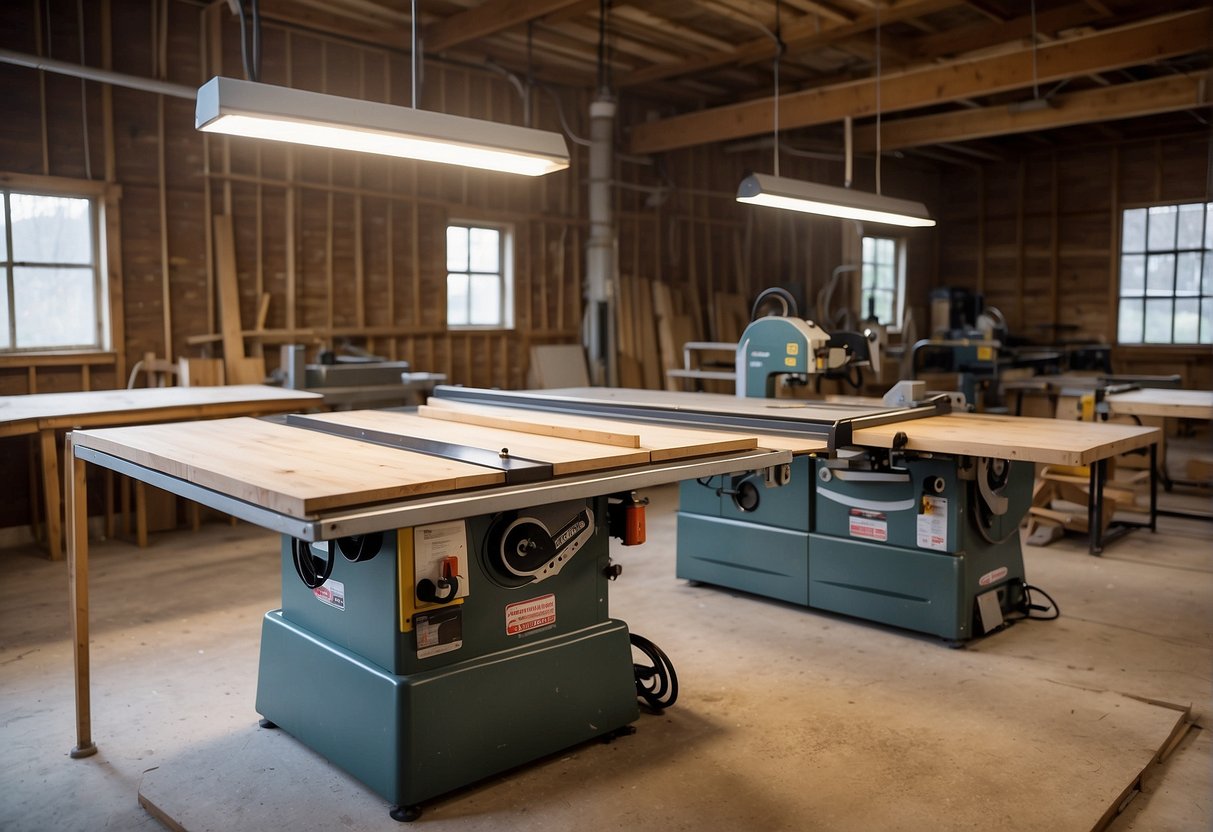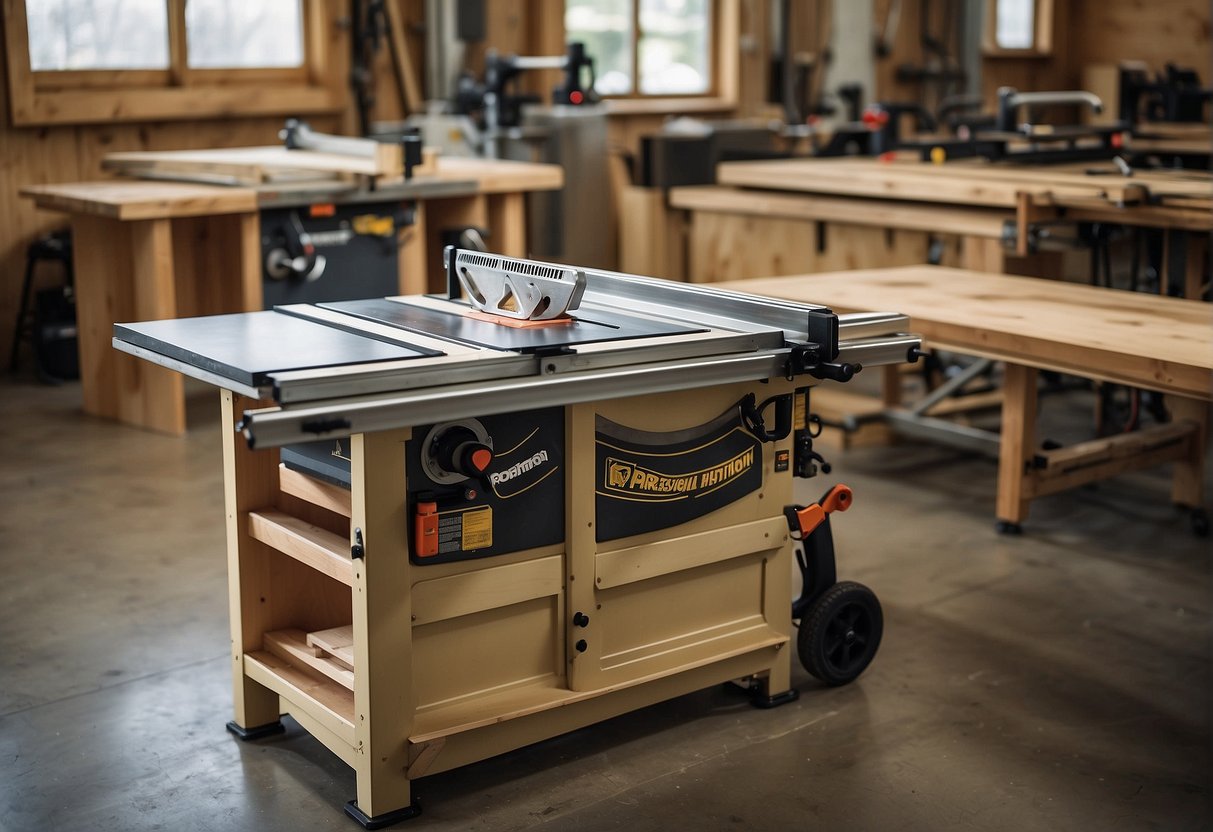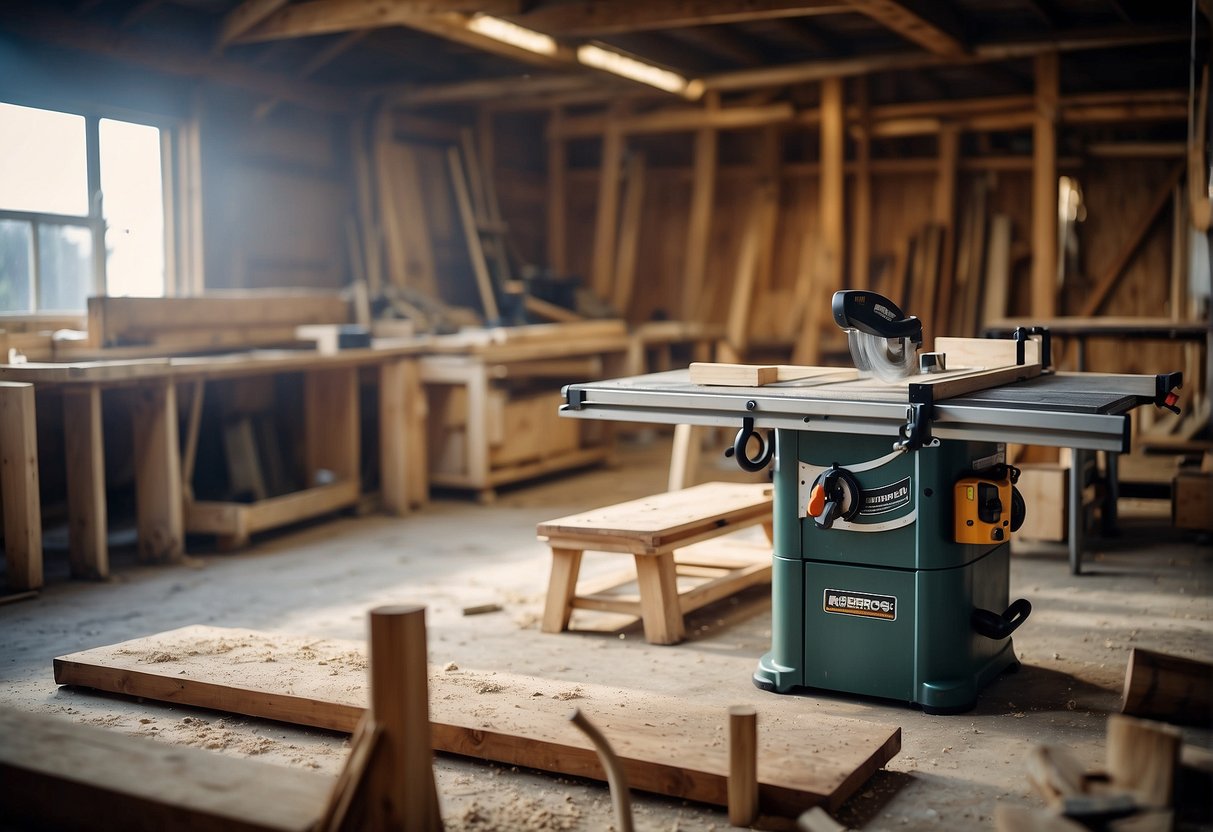As a woodworking enthusiast, I have often been asked about the differences between panel saws and table saws. While both saws are used for cutting wood, they have distinct differences that make them suitable for different tasks. In this article, I will provide a detailed comparison of panel saws and table saws, including their performance, usage, safety, maintenance, cost, and space considerations.
Panel saws are typically used for cutting large sheets of wood, such as plywood, MDF, or particleboard. They are designed to make precise and clean cuts with a minimal amount of effort. On the other hand, table saws are more versatile and can be used for a wide range of cutting tasks, from ripping to cross-cutting. They are also more powerful than panel saws and can cut through thicker and denser materials.
When it comes to choosing the right saw for your projects, it is essential to consider your specific needs and requirements. While panel saws offer superior performance for cutting large sheets of wood, they require more space and are more expensive than table saws. Table saws, on the other hand, are more versatile and can handle a variety of tasks, but they may not offer the same level of precision and accuracy as panel saws.
Key Takeaways
- Panel saws are designed for cutting large sheets of wood with precision, while table saws are more versatile and can handle a wide range of cutting tasks.
- Panel saws require more space and are more expensive than table saws, but they offer superior performance for cutting large sheets of wood.
- When choosing the right saw for your projects, it is essential to consider your specific needs and requirements.
Understanding Panel Saws and Table Saws
As a woodworking enthusiast, I have used both panel saws and table saws in my projects. While both of these saws are designed for cutting wood, they have distinct differences in their design and features. In this section, I will provide an overview of panel saws and table saws, highlighting their design, features, motor, and saw blade.
Design and Features
Panel saws are large, stationary machines that are specifically designed for cutting large sheets of wood. They are typically used in industrial settings, such as cabinet making and furniture manufacturing. Panel saws are usually vertical in nature, which means that they take up a lot of space but don’t require a lot of floor space. They can be used to make straight cuts either vertically or horizontally on large panels. Panel saws are not capable of angular cuts or bevel cuts.
Table saws, on the other hand, are versatile machines that are used for a variety of woodworking tasks, such as ripping, crosscutting, and beveling. They are smaller in size compared to panel saws and can be easily moved around the workshop. Table saws are designed to handle more complicated cuts like bevel cuts and small pieces. They have a flat table surface with a circular saw blade mounted underneath. The blade can be adjusted to different heights and angles to make different types of cuts.
Motor and Saw Blade
Both panel saws and table saws come with different types of motors and saw blades. Panel saws usually have a three-phase motor that is more powerful compared to the motor in a table saw. The motor is designed to handle the large sheets of wood that are typically cut on a panel saw. Panel saws also have rotating saw blades that are designed to cut through thick sheets of wood.
Table saws, on the other hand, come with different types of motors, ranging from 1 to 5 horsepower. The motor is connected to a circular saw blade that is designed to make different types of cuts. The blade can be adjusted to different heights and angles to make different types of cuts.
In conclusion, panel saws and table saws are both useful machines for woodworking projects. Panel saws are designed for cutting large sheets of wood, while table saws are versatile machines that can be used for a variety of tasks. When choosing between a panel saw and a table saw, it is important to consider the type of cuts you will be making and the size of your workshop.
Performance and Usage
As a woodworker, I know that choosing the right saw can make a huge difference in the quality of my work. When it comes to panel saw vs table saw, there are some key differences in performance and usage that are worth considering.
Precision and Accuracy
Precision and accuracy are crucial in woodworking, and both panel saws and table saws can deliver excellent results. However, in general, panel saws are known for their precision and accuracy when it comes to straight cuts on large panels. They are designed to handle large sheets of wood, and their vertical orientation allows for precise cuts without the risk of the material shifting or warping during the cut.
Table saws, on the other hand, are more versatile when it comes to precision and accuracy. They can handle rip cuts, crosscuts, bevel cuts, and angled cuts with ease, making them a great choice for a variety of woodworking projects. However, it’s important to note that the accuracy of cuts on a table saw can be affected by a number of factors, including the quality of the blade, the alignment of the fence, and the stability of the saw itself.
Versatility in Woodworking
When it comes to versatility in woodworking, table saws are the clear winner. They can handle a wide range of cuts, from simple rip cuts to complex bevel cuts and angled cuts. They can also be used for a variety of other tasks, such as dado cuts, rabbet cuts, and more. Additionally, many table saws come with accessories and attachments that can further expand their capabilities.
Panel saws, on the other hand, are more limited in their versatility. They are designed specifically for cutting large panels, and while they excel at this task, they are not as well-suited for other types of cuts. Additionally, panel saws tend to take up more space than table saws, which can be a consideration for woodworkers with limited workshop space.
In conclusion, both panel saws and table saws have their strengths and weaknesses when it comes to performance and usage. Ultimately, the right choice will depend on the specific needs of the woodworker and the types of projects they are working on.
Safety and Maintenance
Safety Features
As a woodworker, safety is of utmost importance to me. Both panel saws and table saws come with safety features that are designed to protect the user from accidents. One of the most important safety features is the blade guard, which helps to prevent accidental contact with the blade. The blade guard should be kept in place at all times, except when making certain cuts where it interferes with the saw’s operation. The riving knife is another important safety feature that helps to prevent kickbacks. Kickbacks can occur when the wood being cut binds between the blade and the fence, causing the wood to be thrown back towards the user. The riving knife helps to prevent this by keeping the wood from binding.
Ease of Maintenance
Proper maintenance of your saw is essential for both safety and performance. Keeping your saw clean and well-lubricated will help to ensure that it operates smoothly and safely. Panel saws tend to be more difficult to maintain than table saws, due to their size and complexity. Table saws are generally easier to maintain, with fewer moving parts and a simpler design. However, both types of saws require regular maintenance to keep them in top condition. Lubrication is an important part of saw maintenance, and should be done according to the manufacturer’s instructions. Regular cleaning is also important, as sawdust can build up and cause problems with the saw’s operation.
In conclusion, both panel saws and table saws come with safety features that are designed to protect the user from accidents. Proper maintenance of your saw is essential for both safety and performance. While panel saws tend to be more difficult to maintain than table saws, both types of saws require regular maintenance to keep them in top condition.
Cost and Space Considerations
As with any tool, cost and space considerations are important when deciding between a panel saw and a table saw. In this section, I’ll discuss the initial investment required for each tool and their respective workspace footprints.
Initial Investment
When it comes to the initial investment required, panel saws tend to be more expensive than table saws. According to Wood Handy, full-size panel saws can range from $2,000 to $6,000, while smaller versions like the Milwaukee compact panel saw can cost less than $2,000. On the other hand, table saws come in a wide variety of prices, with portable table saws costing only a few hundred dollars, and high-end cabinet table saws costing over $5,000.
It’s important to keep in mind that the initial investment is just one factor to consider. Other factors include the long-term cost of maintenance and repairs, as well as the productivity gains that can be achieved with a higher-end tool.
Workspace Footprint
Another important consideration is the amount of space required for each tool. As Handyman’s World points out, panel saws generally take up more physical space than table saws. However, panel saws can be vertical in nature, which means that although they do need a lot of space, they don’t actually take up a lot of floor space.
Table saws, on the other hand, are more compact and take up less space overall. This makes them a better choice for smaller workshops where space is at a premium. However, they may not be as well-suited for handling larger sheets of material as panel saws are.
Overall, it’s important to consider the initial investment and workspace footprint when deciding between a panel saw and a table saw. While panel saws tend to be more expensive and take up more space, they may be a better choice for handling larger sheets of material. On the other hand, table saws are more compact and may be a better choice for smaller workshops.
Choosing the Right Saw for Your Projects
When it comes to woodworking, choosing the right saw can make all the difference in the outcome of your project. Panel saws and table saws are both great options, but which one is right for you? Here are a few things to consider when choosing between a panel saw and a table saw.
Project Types and Materials
The type of project you are working on and the materials you are using can greatly influence which saw is right for you. If you are working with large sheets of materials such as plywood, MDF, or melamine sheets, a panel saw may be the better choice. Panel saws are optimized for cutting large sheets of materials quickly and accurately.
On the other hand, if you are working with solid wood, laminates, or smaller sheet goods, a table saw may be a better choice. Table saws are versatile and can handle a wide range of materials, making them a great choice for a variety of woodworking projects.
Professional Needs vs. Hobbyist Projects
Another thing to consider when choosing between a panel saw and a table saw is whether you are a professional woodworker or a hobbyist. If you are a professional woodworker who needs to make precise cuts quickly and efficiently, a panel saw may be the better choice. Panel saws are designed for speed and accuracy, making them a great choice for professionals who need to get the job done quickly.
However, if you are a hobbyist who enjoys woodworking as a hobby, a table saw may be a better choice. Table saws are versatile and can handle a wide range of materials, making them a great choice for hobbyists who want to experiment with different types of woodworking projects.
In conclusion, choosing the right saw for your woodworking project depends on a variety of factors, including the type of project you are working on, the materials you are using, and whether you are a professional woodworker or a hobbyist. By considering these factors, you can choose the saw that is right for you and your woodworking needs.
Frequently Asked Questions
What are the primary differences in usage between a panel saw and a table saw?
Both panel saws and table saws are used for cutting wood, but they have different primary purposes. A panel saw is designed to cut large sheets of wood, such as plywood or MDF, in a vertical or horizontal direction. A table saw, on the other hand, is designed to make precise cuts on smaller pieces of wood, such as ripping or crosscutting.
How do the costs of panel saws and table saws compare?
Panel saws are generally more expensive than table saws. A panel saw can range from a few thousand dollars to tens of thousands of dollars, depending on the size and features. A table saw, on the other hand, can range from a few hundred dollars to a few thousand dollars.
In what scenarios is a panel saw more advantageous than a table saw?
A panel saw is more advantageous than a table saw when you need to make precise cuts on large sheets of wood. It is also more efficient when you need to cut a lot of sheets of wood quickly. Additionally, a panel saw is safer to use than a table saw for large sheets of wood.
For what types of materials and cuts is a panel saw most suitable?
A panel saw is most suitable for cutting large sheets of wood, such as plywood, MDF, or particleboard. It is also suitable for making straight cuts in these materials, either vertically or horizontally.
What are the limitations of using a table saw compared to a panel saw?
The main limitation of using a table saw compared to a panel saw is the size of the material that can be cut. A table saw is limited to the size of the table, and it can be difficult to cut large sheets of wood on a table saw. Additionally, a table saw can be dangerous when cutting large sheets of wood.
How does a sliding table saw attachment enhance a traditional table saw?
A sliding table saw attachment enhances a traditional table saw by allowing the user to make precise cuts on larger pieces of wood. It also makes it easier to cut large sheets of wood, as the wood can slide smoothly across the table. This attachment also makes it safer to cut large sheets of wood on a table saw.

Hi, I’m Sal Muller of Tooltrip.com. My DIY experience led me to understand essential power tools for home projects. Tooltrip.com guides enthusiasts and professionals in choosing right tools for any job. I provide concise top tool reviews for easier, efficient DIY.




